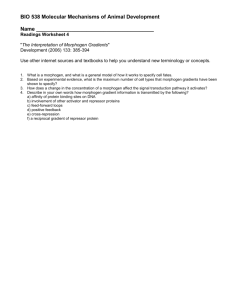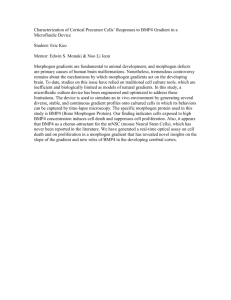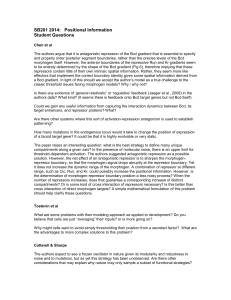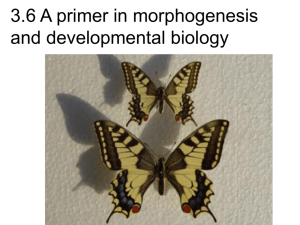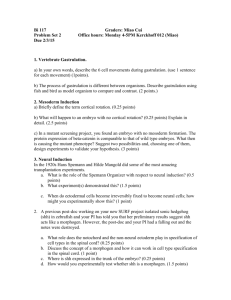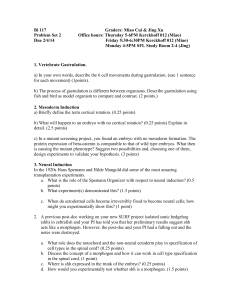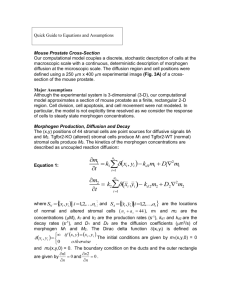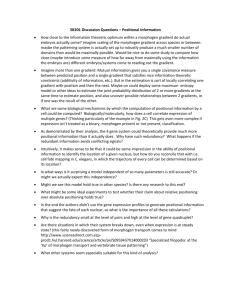Optimizing the Read-out of Morphogen Gradients Abstract Eldon Emberly
advertisement
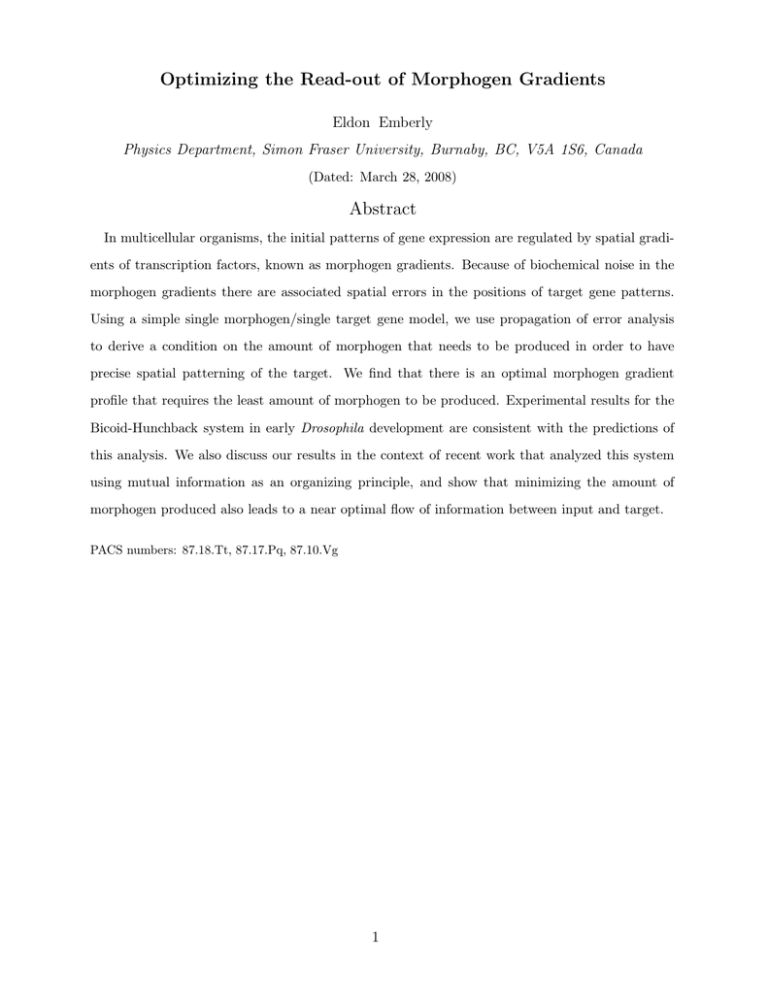
Optimizing the Read-out of Morphogen Gradients Eldon Emberly Physics Department, Simon Fraser University, Burnaby, BC, V5A 1S6, Canada (Dated: March 28, 2008) Abstract In multicellular organisms, the initial patterns of gene expression are regulated by spatial gradients of transcription factors, known as morphogen gradients. Because of biochemical noise in the morphogen gradients there are associated spatial errors in the positions of target gene patterns. Using a simple single morphogen/single target gene model, we use propagation of error analysis to derive a condition on the amount of morphogen that needs to be produced in order to have precise spatial patterning of the target. We find that there is an optimal morphogen gradient profile that requires the least amount of morphogen to be produced. Experimental results for the Bicoid-Hunchback system in early Drosophila development are consistent with the predictions of this analysis. We also discuss our results in the context of recent work that analyzed this system using mutual information as an organizing principle, and show that minimizing the amount of morphogen produced also leads to a near optimal flow of information between input and target. PACS numbers: 87.18.Tt, 87.17.Pq, 87.10.Vg 1 A developing organism generates its complex pattern of tissue specification by controlling the precise spatial patterning of its genes. Initially, there are so called morphogen gradients, that correspond to spatially graded patterns of biochemical factors that regulate the expression of a set of target genes1 . These target genes generate more complex patterns of spatial expression that in turn regulate further downstream genes, ultimately leading to patterns of expression that have the single cell precision required for many developing tissues2 . Behind all of this spatial patterning are noisy chemical reactions that can lead to cell to cell variation in input and output expression3,4 . This biochemical noise in turn leads to spatial uncertainty in the expression patterns. If the organism requires that patterns should be patterned to a specific precision then this will set bounds on what the biochemical noise can be. A well studied morphogen gradient is the embryonic expression pattern of the transcription factor bicoid in the developing fruit fly5 . The Bicoid profile decays along the anterior to posterior axis of the embryo and regulates the expression of several target genes, one of which is the transcription factor Hunchback6 . Unlike Bicoid, the expression profile of Hunchback shows a sharp transition half-way along the egg’s length. It has been shown that this sharp transition can be generated through the action of Bicoid alone7 . There is now quantitative data for the expression levels and noise in the Bicoid-Hunchback system 8,9 thus providing the chance to analyze how the organism controls biochemical noise so as to achieve a certain level of spatial resolution. In setting this spatial precision and balancing its noise requirements the organism can choose among a host of morphogen gradient profiles and target gene responses. How does it choose? On setting the morphogen gradient, there has been prior work that focused on the physical mechanisms which could lead to robust profiles10 . With respect to choosing the specific input/output response, recent work has suggested that the organism might be trying to optimize the flow of information from the morphogen to the target11 . Other work has focused on the limits of precision imposed by the biochemical noise12 . In this paper, using complementary analysis we will argue that in addition to the possibility of maximizing information transfer, the organism may also be trying to choose the morphogen profile which minimizes the amount of cellular resources that are used to set up the gradient. In many developing organisms there are initial morphogen gradients that decay along one spatial dimension. A given morphogen gradient, described by an average concentration 2 profile, c(x) along its primary axis, x, is then read-out by target genes that typically show much sharper transitions and define spatial boundaries (see Fig. 1). For a single target that sets up a single spatial boundary, we define the transition to occur at a specific spatial location x1/2 where its concentration is half of its maximal value. For simplicity we will assume that the initial morphogen gradient decays exponentially with position; which has been shown to be the case for the morphogen Bicoid in the Drosophila embryo8 and is the solution profile for diffusion from a localized source with uniform degredation12 . Thus the average concentration of the morphogen, c(x) along its axis, x can be written as, c(x) = F exp(x1/2 /λ) exp(−x/λ) (1) where λ is a decay constant and F is the concentration at x1/2 . Due to the biochemical reactions that produce this gradient, there will also be associated fluctuations around the above average value. We will assume that the variance in the average concentration is Poissonian and goes as δc2 (x) = c(x), which matches well with the noise profile of the Bicoid √ gradient8 . Hence, the noise at x1/2 in the morphogen gradient is δc (x1/2 )/c(x1/2 ) = 1/ F , and thus F sets the biochemical noise level in the input at the target’s spatial boundary. Most target genes display Hill function characteristics as a function of their input’s concentration (target response in Fig. 1). Thus the average concentration of a target gene, g(c), that has a transition at x1/2 as a function of the input concentration, c, where c(x1/2 ) = F can be written as g(c) = (c/F )m 1 + (c/F )m (2) where m is a measure of the cooperativity or specificity of the response. This target gene is measuring the concentration of the input morphogen. Transcription requires the diffusion of transcription factors to cognate binding sites in the promoter of the target, and hence measuring the input’s concentration accurately is limited by diffusion and the amount of time spent measuring the signal13 . Irrespective of these diffusion limited measurement inaccuracies, there will also be associated fluctuations in the output signal that are in part due to the inherent biochemical fluctuations of the input signal. We now consider how this impacts the limits of precision on the spatial boundary of the target. In order for proper development to proceed, the organism often requires the spatial boundary of the target gene to meet a specified amount of spatial precision. For instance if the target gene is to be utilized to set a sharp boundary later in development then the width of 3 its transition must be narrow. Since g(c) depends implicitly on the spatial location, x, we can define a transition width, ξx , that is a measure of how sharp the target gene’s boundary is (see Fig. 1). This is given by, −1 1 dg ξx = 2 dx x=x 1/2 −1 dc −1 dx 1 dg = 2 dc c=F = x=x1/2 2λ . m (3) Thus the transition width, ξx , depends on both the shape of the morphogen via λ and also on the cooperativity of the target gene’s response, through m. Increasing m leads to a sharper transition for a fixed λ, while increasing λ for fixed m causes the transition to be more broad. Or conversely, Eq. (3) states that there are different morphogen and target gene function combinations that can lead to the same transition width. If the organism is trying to have a fixed transition width, how does it choose between these different combinations? In order to answer the above question, we must take into account that responding cells must be able to measure this transition accurately. More precisely, the accuracy of the spatial measurement requires that the spatial error associated with the cell-to-cell fluctuations in g(c) should be less than the transition width, ξx . The spatial error at the boundary, δx , associated with the corresponding target gene’s fluctuations, δg is given by, δx = dg −1 δg dx = x=x1/2 dc −1 δc (x) dx x=x1/2 λ =√ F (4) where we have assumed that the fluctuations in the output δg are determined solely by the input fluctuations via δg = |dg/dc|δc. Under this assumption the error in position is solely specified by the fluctuations in the input morphogen gradient. If the transition occurs over n cells of width ∆x and we make the conservative assumption that noise fluctuations are shared equally over these cells, then the requirement that the spatial error fluctuations should be less than or equal to the transition width, gives n δx ≤ ξx = n ∆x (5) This leads to the simple requirement that δx ≤ ∆x, which states that the spatial error associated with the morphogen’s fluctuations is bounded by the cellular width. (This is too conservative a bound, and could be relaxed to the far more generous bound of δx ≤ ξx , but the following results do not depend on either choice). The above relation sets a requirement that the morphogen concentration at the transition must be F ≥ (λ/∆x)2 . Broader λ thus 4 requires a larger concentration at the transition in order to keep the noise below the desired threshold. With F fixed by the above constraint, the spatial error is guaranteed to be less than the cellular dimensions at the transition boundary, and thus an accurate measurement of the transition by the target gene can be made. By substituting the above value of F that bounds fluctuations into Eq. (1), we arrive at the steady-state concentration profile for c(x) that will yield a precise output transition at x1/2 for a given decay constant, λ. The total amount of morphogen at steady-state is given by !2 λ λ3 (x1/2 −1)/λ 1/λ e [e − 1]. (6) ctot = ex1/2 /λ e−x/λ = dx ∆x ∆x2 0 Thus at steady state, the organism must make this amount of morphogen in order to allow Z 1 the target gene to make an accurate measurement of the transition boundary. This function is plotted as a function of λ in Fig. 2(a), and is seen to go through a minimum. Assuming that the expenditure of cellular resources to maintain the morphogen gradient is proportional to ctot , then the organism could minimize these expenditures by choosing λ∗ such that ctot is minimized. Setting dctot dλ = 0 yields the following equation for λ∗ , ! 1 1 = ln +1 . ∗ ∗ λ 3λ − x1/2 (7) This equation has a unique solution for positive λ∗ , with λ∗ > x1/2 /3. Thus for a given target gene transition boundary, x1/2 , there is an optimal decay length for the morphogen gradient that minimizes the amount of morphogen protein that the organism needs to produce. For a target gene with cooperativity, m, the corresponding spatial resolution of the transition is given by ξx∗ = 2λ∗ /m. Or conversely, we can answer the question that was posed earlier, namely that if the organism wishes to have a specified transition width, ξx , then it can set the cooperativity of the target gene’s response to be m∗ = 2λ∗ /ξx , which will then minimize the amount of morphogen protein required. We also note that if evolutionary constraints make m difficult to alter such that ξx∗ proves to be too broad a transition width, then λ could be decreased to obtain the desired ξx . The price for this decreased λ would be a greater total morphogen amount according to Eq. 6. It is illustrative to explore the above results in the context of the developing Drosophila embryo where the Bicoid morphogen gradient is read off by the target gene hunchback. The transition boundary of Hunchback occurs at half the egg length that corresponds to x1/2 = 0.5. The decay constant for the gradient that would minimize the amount of Bicoid 5 protein is λ∗ = 0.168 which is in good agreement with the measured decay constant of λm = 0.28 . The cooperativity of the Hunchback response to Bicoid has been measured to be m = 58 . With this value for m, the optimal transition width is found to be ξx∗ = 0.07, or 7% of the egg length, which is consistent with observed widths of the Hunchback response prior to cellularization7 . With this transition width the fluctuations in the input are bounded √ √ by 1/ Fmax = 0.09 < δc /c < 1/ Fmin = 0.41. The observed fluctuation at the transition point is δc,m /c = 0.1 that is within the above bounds. Thus the measured experimental data are consistent with predictions derived from the assumption that the organism is trying to make as little morphogen as possible while keeping fluctuations bounded. In addition to the above possibility of setting up morphogen gradients which minimize the expenditure of cellular resources, it has been recently proposed that the organism may also be trying to optimize the passage of information from the input morphogen to the output target11 . This corresponds to maximizing the mutual information, I(g, c) between input, c, and output, g, given by, I(g, c) = Z dc P (c) Z dg P (g|c) log2 P (g|c) P (g) ! (8) where P (c), P (g) are the respective input/output distributions and P (g|c) is the conditional probability between input and output that characterizes the target’s response. Since a target gene’s response, P (g|c) is fixed by its promoter, it is argued that the organism might be trying to optimize the mutual information by adjusting the input morphogen distribution P (c). They calculated the mutual information from the experimental Bicoid-Hunchback distribution and compared it to the case where the Bicoid input distribution was optimized so as to maximize the mutual information. The experimental mutual information was found to be ≈ 90% of the optimal case and so it was argued that the Bicoid gradient might be set by the organism to maximize the flow of information. We have analyzed the possibility of the organism maximizing the Bicoid-Hunchback mutual information in the context of the model for the input and output responses given in Eqs. (1-2) along with the corresponding noise characteristics (see Appendix for details). Using the parameters F = 100, x1/2 = 0.5 and m = 5 that closely match the experimental morphogen profile, output response and noise fluctuations at the midpoint, we have calculated the mutual information I(g, c) as a function of decay length λ (Fig. 2(b)). It can be seen that the λ which maximizes the mutual information is λopt ≈ 0.35. However the mu6 tual information over the range from the experimentally measured λm = 0.2 to λopt = 0.35 does not change much, with the mutual information at λm being 93% of the optimal value. Based on these findings, it seems that the organism can fortuitously minimize the amount of morphogen produced while at the same time managing to be near optimal in the passage of information. In summary, we have used propagation of error analysis to derive a condition on the amount of morphogen that needs to be produced (Eq. (6)) in order for a target gene to meet the desired spatial precision of its transition boundary. This condition predicts that there is an optimal morphogen decay length which minimizes the amount of required morphogen. The experimental data for the Bicoid-Hunchback system is at least consistent with the predictions from this analysis. In addition to this we also showed that the mutual information is rather insensitive to the decay length and that in minimizing the amount of morphogen produced it could also achieve a near optimal passage of information from input to target. It will be interesting to test this analysis on other morphogen gradient systems like the readout of the Dpp morphogen gradient in the developing wing-disc of Drosophila14 . Currently quantitative data on the profiles and noise distributions of the morphogen and targets are lacking, and the system is complicated by other opposing input morphogen gradients. Only with the aquisition of such data will it become clearer as to how an organism chooses to set up its morphogen profiles and target responses, if it cares to choose at all. EE would like to thank Malcolm Kennett for useful discussions and acknowledge the financial support of NSERC and CIFAR in carrying out this work. I. APPENDIX In order to calculate the mutual information, Eq. (8), from the model outlined in Eqs. (12), the distributions P (c), P (g|c), and P (g) need to be evaluated. Eqn. (1) specifies the average concentration of the input morphogen, c(x), as a function of position x, and we assume that the variance about this average is δc2 = c(x). Assuming that the distribution P (c|x) of c at a given x is Gaussian, then P (c) is calculated by, P (c) = Z x=1 x=0 −(c − c(x))2 exp dx q . 2δc2 (x) 2πδc2 (x) ! 1 7 (9) With respect to the conditional probability distribution P (g|c), we assume that it follows a gaussian distribution centered about an average average output, g(c), with a variance δ g2 (c) for a given input level, c. Thus P (g|c) is given by, −(g − g(c))2 P (g|c) = q exp 2δg2 (c) 2πδg2 (c) 1 ! (10) Since the output g depends on the input c its variance is given by δg2 (c) = |dg(c)/dc|2δc2 and using the average output function for g(c) given by Eq. 2, the fluctuations in g are given by, δg (c) = √ m(c/F )m c[1 + (c/F )m ]2 (11) Using the above two distributions, the probability distribution P (g) can be computed via, P (g) = Z dc P (c)P (g|c) (12) Thus if the parameters in the model, F , x1/2 , λ and m are specified, the above two distributions can be evaluated and the mutual information, Eqn. (8), can be calculated. In optimizing the mutual information, λ is adjusted until the maximal value of the mutual information is obtained. 1 L. Wolpert, J. Theor. Biol. 25 1 (1969). 2 For an excellent introduction to animal development and spatial patterning via morphogens see the book, “From DNA to Diversity” by S. B. Carroll, J. K. Grenier and S. D. Weatherbee, Blackwell Science Publishing, (2001). 3 M. B. Elowitz, A. J. Levine, E. D. Siggia and P. D. Swain, Science 297, 1183 (2002). 4 M. Thattai and A. van Oudenaarden. PNAS 98, 8614 (2001). 5 W. Driever and C. Nüsslein-Volhard, Cell 54, 83 (1988). W. Driever and C. Nüsslein-Volhard, Cell 54, 95 (1988). 6 W. Driever and C. Nüsslein-Volhard, Nature 337, 138 (1989). 7 O. Crauk and N. Dostatni. Curr Biol. 15, 1888 (2005). 8 T. Gregor, D. W. Tank, E. F. Wieschaus, and W. Bialek, Cell 130, 153 (2007). 9 B. Houchmandzadeh, E. Wieschaus, and S. Leibler, Nature 415, 798 (2007). 10 A. Eldar, D. Rosin, B. Z. Shilo and N. Barkai. Dev Cell 5, 635 (2003). 8 11 G. Tkacik, C. G. Callan, and W. Bialek, q-bio/070501313 (2007) 12 F. Tostevin, P. Rein ten Wolde, M. Howard. PLOS Comp. Bio. 3, 0763 (2007). 13 H. Berg and E. Purcell. Biophys J 20, 193 (1977). 14 For an excellent review of morphogen gradients in the developing wing of Drosophila, see T. Tabata and Y. Takei. Development 131, 703 (2004). 9 Morphogen (Input) Target (Output) 700 1 600 0.8 400 δc 300 [g] [c] 500 0.6 δg 0.4 200 0.2 100 0 0 0.2 0.4 0.6 position (x) 0.8 0 0 1 50 100 [c] 150 200 1 δx [g] 0.8 0.6 0.4 0.2 0 0 2ξ 0.2 x 0.4 0.6 position (x) 0.8 1 Target Spatial Boundary Emberly Fig. 1 FIG. 1: Schematic of morphogen gradient read-out by a target gene. The morphogen gradient, c decays along one of the spatial dimensions of the organism (left top panel). The biochemical noise that exists in the generation of this gradient causes fluctuations in the input, δ c . The morphogen gradient is read-out by a target gene, g, that is assumed to have a Hill function type of response to the input (right top panel). Due to the fluctuations in the input gradient, the target gene has output fluctuations δg . The target gene’s response as a function of spatial position is shown in the bottom panel. It exhibits a transition from high to low expression at a position x 1/2 , which happens to be 0.5 in the figure. The transition also has a characteristic spatial width given by ξx = (1/2)|dg/dx|−1 . Because of the fluctuations in the target gene’s expression, there is also a corresponding error in position given by δ x . In order for a precise resolution of the boundary, δ x is bounded to be within ξx . 10 (a) 1500 1250 λ ∗ 0.2 0.3 Mut. Info. (bits) ctot 1000 750 500 250 0.1 2.2 (b) 2.1 2 1.9 1.8 1.7 1.6 0.1 0.4 0.5 0.4 0.5 λopt 0.2 0.3 λ Emberly Fig. 2 FIG. 2: (a) Plot of the amount of morphogen, c tot , that would lead to an accurate spatial boundary as a function of decay length, λ. The cell width was taken to be ∆ x = 0.016 of the egg length, and the spatial boundary was set to x 1/2 = 0.5. For this value of x1/2 , the decay length which minimizes ctot is at λ∗ = 0.168. (b) Mutual information as a function of decay length, λ, using parameters F = 100, x1/2 = 0.5 and m = 5. 11
